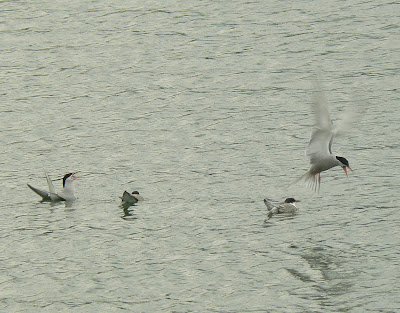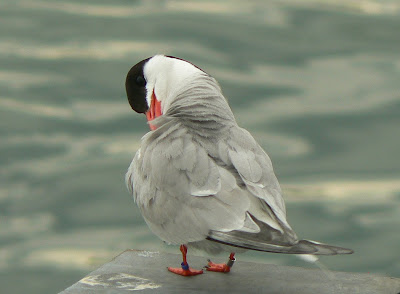Juvenile Common Tern beginning to look like an adult
(Just to clarify and thanks to Chris Batty for highlighting the need for clarification – not this year's bird but a returning Common Tern. As you will know Common Terns leave in autumn to spend our winter in West Africa... this is a first or second summer bird. )
We had already had a torrential downpour, rain was in the air and the sky was threatening and subsequently lived up to the threat. As a consequence it was more like night than day... a real test for any photography and being inept I was never going to get a 'great' shot. You may see the rain on the water in some of the images. Armed with a large umbrella I decided it would be worthwhile to see what stage of development the young terns were now at.

Relationships were reinforced
Gosh what a racket! Squabbling, posturing and feeding Terns everywhere calling to each other, at each other and for each other. It was quite good fun watching all this behaviour. The bundles of fluff that was the new-born have grown into what nearly looks like adults and even taken to the air – sort of. I managed to count 14 Common Terns, I think, certainly 13, including at the moment 3 juveniles. The reason I say I think is there is so much activity with birds coming and going they are never in one place long enough to establish a head count. It is interesting that the Common Terns command the south side of the dock and wo betide any intruders, whereas the Gulls seem to have settled for the north side... but that may also be due to the detritus fed to them from the local takeaways. Nevertheless the Common Terns have also begun to take over the end of those floating pontoons on the north side too... hence the difficult head count.
Someone looking to rob an easy meal?
Catching fish is one thing – getting it safely home is another
At last...
I think our male Common Tern from last year was doing all the feeding, he was at least seen more than once with fish in his beak and feeding the juveniles, but also reinforcing his relationship by bringing food back for 'her in-doors'. As a consequence any fish brought to beak led to continual and constant harassment by other adult terns. An adult with food for junior frequently undertook one or two flybys before being able to land and pass-on the catch, but sometimes simply had to land elsewhere first. At one point there was one adult with food with a trail of four would be interceptors. I am curious to know what they are feeding on, what type of fish and where they are being caught, not really seen any fishing in the Dock itself, although I have seen the odd plunge dive.
Trial flights don't always go to plan
Mum and Dad pop by to add encouragement...?
The eldest two of the young Common Terns have taken to the air but are still finding their wings. As a consequence at one point the two of them ended up ditching into the water. This attracted the attention of the adults. It wasn't clear if they were being 'mobbed' by other non parental adults whereas two grown-ups did land alongside. A great deal of discussion and shouting appeared to take place, I assume by way of encouragement. But the parents soon left leaving the youngsters to it. A great deal of flapping and at first I thought they were bathing before realising it was frantic attempts to get airborne. The eldest eventually succeeding and flopped onto one of the pontoons leaving what I again assume to be the younger sibling still on the water. After another few minutes this too achieved an aerial return to the pontoon. Throughout, the youngest remained quietly behind, often flattened to the pontoon adjacent to the tyre that has served as home for he last few weeks waiting to be fed.The adult male made one of his visits to the post for a bit of peace and quiet to do some feather rearrangement.
I am reliably informed by Chris Batty from the Fylde Bird Club that this bird was ringed as a chick at Doffcocker Lodge, Bolton, Greater Manchester on 14th June 2006. The ring number is SV43507.
The skies darkened and I mean darkened, so it was time to leave, but it looked as if it might clear out to the west so I decided to pop down to Newton Marsh. Boy did the heavens open, within five minutes a true thunderstorm that battered down which even the windscreen wipers failed to deal with.
Newton Marsh was particularly quiet, not surprising at this time of year and the water level is particularly low. However the constant and continual shotgun sound from Longton Clay Pigeon Shoot may not have helped. Doesn't seem to be an ideal location for such an activity, I would have thought it would disturb wildlife and wader roosts out on Longton and Clifton Marsh, but what do I know.
Newton Marsh – What is it?
One matter I would seek your opinion on is – swallows often use the road as a feeding station and swoop and patrol the tarmac itself, maybe it is a bit warmer with residual heat than elsewhere and attract insects and I have seen Swallows land on the road here! I proceeded to the United Utilities plant at the end of the road and turned around at the gates. I 'drive' on idle, i.e as slow as possible, just keeping the wheels turning. The windows were covered in rain but before me, heading straight at the car, at two feet above the tarmac of the road hurtled a falcon. Slate grey wings; the two wings flashed past the car at speed and gone. I did see a patch of orange somewhere as it hurtled by. It wasn't very big and my immediate thought was a male Merlin, which are known to hunt hereabouts. Subsequently the 'flash of orange' worried me and I wondered about 'Hobby', then the obvious 'Sparrowhawk'. It didn't seem big enough for Sparrowhawk and I have seen quite a few and I didn't think it was. I put the complete wingspan down to the size of my steering wheel and having just measured it at 14 inches (36cm) At the height I wondered if it was pursuing Swallows along the road and if a Sparrowhawk would exhibit this behaviour. Last year I found a Hobby feeding on a fence post hereabouts. I'll probably never know, if you have any thoughts or want to guess, I'll be pleased to hear what you think.
| Powered by website analytics technology. |














3 comments:
Apologies for the layout but this blog keeps going pear-shaped for some reason. I need to learn and examine the html code!
Certainly the 'compose' function doesn't work too well, but perhaps I'm asking too much of it. (how hard is it to add text, captions and photos and centre or range left? Any advice readily accepted.
I have the same problem sometimes, I just remove the photo and then re post it making sure it is set to centre, not sure if it helps.
Some great photo's I saw them last year and earlier this year but must make a trip back to get some photos myself.
Derek
Thanks for popping by Derek and thank you for the comment and advice.
I have followed your advice and some improvement, but still not as I intended. Caption size keeps changing size on its own too... oh well.
Hopefully in time I can resolve the issues.
Post a Comment